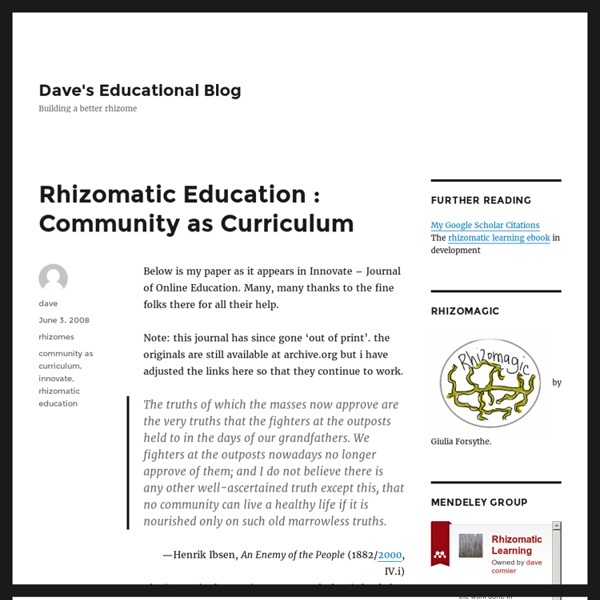Introduction | Making the community the curriculum
Rhizomatic Learning posits, among other things, that the community is the curriculum. That being able to participate with and among those people who are resident in a particular field is a primary goal of learning. In each of my classes the curriculum is, of course, filled with the ideas and connections that pre-exist in the field but the paths that are taken by the students are as individual as they are, and the path taken by the class is made up of the collected paths chosen by all the students, shaped by my influence as an instructor and the impact of those external nodes they manage to contact. What follows is an artifact of different ecologies of learning. A given chapter represents my best guess about a direction that would best serve the overall path the class was on. Here’s a talk I gave to the excellent #etmooc group on rhizomatic learning
Assessment and Rhizomatic Learning – Course start Tuesday | Making the community the curriculum
Well… it’s that time of the year again folks. Time for me to teach my Educational Technology and the Adult learner course. I think of myself as being very privileged to teach this course every year. The course is, in many important ways, unfettered by its institutionality. It not connected to any other courses in any registrarial way… no pre-requisite, no follow up courses. And the students are fascinating. Some have never stepped foot in the classroom as teachers. I need to give them all a number grade. Learning Contract When i taught this course three years ago, a finishing student of mine said “you know, I think i understand your whole rhizome thing… but you know what it needs? What I learned year one Many of my students were actually quite familiar with the idea of a grading contract… which I hadn’t expected. Shortfalls… It lacked depth of choice. What I’m doing this year Two whole days before we get started and I’m still tweaking the sections. Optional Thursday? Twitter Chat Yay!
Dave Cormier discusses cMOOC and MultiMOOC, connectivism, and openness in learning | EnglishBridges
Venue: Bb Collaborate / Elluminate, with thanks to Recording: Dave talked about his ideas on learning and differentiated the nature of what needed to be learned into David Snowden's simple, complicated, complex, and chaotic. We expected to ask Dave about And if conversation flags (not likely :-) ... Announcements Sun, Jan 20, 2013 - 15:00 GMT - Benjamin Stewart hosts TILL Sunday discussion of ePortfolios in Language Learning The time of the TILL Sunday event on ePortfolios in Language Learning, hosted by Benjamin Steward in a Hangout, has been changed to 15:00 GMT Jan 20 On the agenda, 2 readings: To this, Vance might add, for MultiMOOC participants: Hangouts are created on the fly, so their URLs are not generated until just before the event. Sun, Jan 20, 2013 - 1500 GMT - IATEFL Webinar: ICT debate about IWBs
MOOCs as a Gathering Place | Sloan-C eLearning Landscape
At a recent conference, David Wiley, open education pioneer said that MOOCs (massive open online courses) were essentially 1999 online learning with the password protection taken away. He’s certainly not alone in his dislike of all things MOOC – and no wonder. In the last three years the theory-work of decades of educators has been ignored and co-opted. A few good self-branders have suddenly discovered people can learn online. Worse, these people are becoming the voices of online learning and are, in some cases, claiming to be the discoverers of educational approaches we’ve all been using since the dawn of the Internet. I have a complex relationship with the word MOOC. We are all aware, at this point, that the Internet has ushered us into a powerful moment in the history of learning. Access to information, however, is not the real transformative change that excites me about learning on the Internet. Compare that to my hometown in Northern New Brunswick, Canada. Written by Like this:



